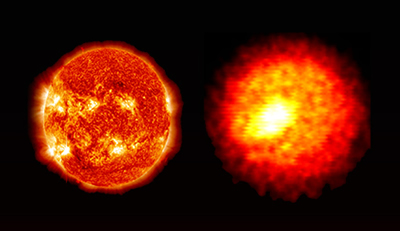Papers and Presentations - 2017
August
Probing the Conditions of Stellar Interiors
Most of the nuclear reactions that drive the nucleosynthesis (formation) of the elements in the universe occur in extreme stellar plasma conditions. This intense environment found in the deep interiors of stars has made it nearly impossible for scientists to perform nuclear measurements in these conditions—until now.
In a unique cross-disciplinary collaboration between the fields of plasma physics, nuclear astrophysics, and laser fusion, a team of researchers from LLNL, Ohio University, the Massachusetts Institute of Technology (MIT), and Los Alamos National Laboratory (LANL), describe experiments performed on NIF in conditions like those of stellar interiors. The team’s findings were published on Aug. 7 by Nature Physics.
3D visualization of a Hubble Space Telescope image of the balloon-like Bubble Nebula, which is expanding in space from a super-hot, massive star 45 times more massive than the sun (seen moving from the 7 o’clock to the 9 o’clock position in the image). Gas on the star gets so hot that it escapes away into space as a “stellar wind” moving at more than four million miles per hour. The Bubble Nebula is seven light years across (about 42 trillion miles) and about 7,100 light years from Earth in the constellation Cassiopeia. Credit: NASA, ESA, and the Hubble Heritage Team (STScI/AURA)The experiments are the first thermonuclear measurements of nuclear reaction cross-sections—a quantity that describes the probability that reactants will undergo a fusion reaction—in high-energy-density plasma conditions that are equivalent to the burning cores of giant stars, 10 to 40 times more massive than the sun. These extreme plasma conditions boast hydrogen-isotope densities compressed by a factor of a thousand to near that of solid lead, and temperatures heated to about 50 million kelvin. These are the conditions in stars that lead to supernovae, the most massive explosions in the universe.
“Ordinarily, these kinds of nuclear astrophysics experiments are performed on accelerator experiments in the laboratory, which become particularly challenging at the low energies often relevant for nucleosynthesis,” said LLNL physicist Dan Casey, the lead author on the paper. “As the reaction cross-sections fall rapidly with decreasing reactant energy, bound electron screening corrections become significant, and terrestrial and cosmic background sources become a major experimental challenge.”
NIF is the only experimental tool in the world capable of creating temperatures and pressures like those found in the cores of stars and giant planets. Using the indirect-drive approach to inertial confinement fusion (ICF), the NIF lasers drove a gas-filled capsule implosion, heating target capsules to extraordinary temperatures and compressing them to high densities where fusion reactions can occur.
 Despite staggering differences in mass and scale—the sun (left) is approximately 1038 times more massive and 1013 times larger—NIF implosions (right) are being used to recreate the conditions found in the deep interiors of stars.
Despite staggering differences in mass and scale—the sun (left) is approximately 1038 times more massive and 1013 times larger—NIF implosions (right) are being used to recreate the conditions found in the deep interiors of stars. “One of the most important findings is that we reproduced prior measurements made on accelerators in radically different conditions,” Casey said. “This really establishes a new tool in the nuclear astrophysics field for studying various processes and reactions that may be difficult to access any other way.”
“Perhaps most importantly,” Casey added, “this work lays groundwork for potential experimental tests of phenomena that can only be found in the extreme plasma conditions of stellar interiors. One example is of plasma electron screening, a process that is important in nucleosynthesis but has not been observed experimentally.”
Now that the team has established a technique to perform these measurements, related teams like one led by Maria Gatu Johnson at MIT are looking to explore other nuclear reactions and ways to attempt to measure the impact of plasma electrons on the nuclear reactions (see “NIF Experiments Study How ‘Starstuff’ Is Made”).
Casey was joined by co-authors Daniel Sayre, Vladimir Smalyuk, Robert Tipton, Jesse Pino, Gary Grim, Bruce Remington, Dave Dearborn, Laura (Robin) Benedetti, Robert Hatarik, Nobuhiko Izumi, James McNaney, Tammy Ma, Steve MacLaren, Jay Salmonson, Shahab Khan, Arthur Pak, Laura Berzak Hopkins, Sebastien LePape, Brian Spears, Nathan Meezan, Laurent Divol, Charles Yeamans, Joseph Caggiano, Dennis McNabb, Dean Holunga, Marina Chiarappa-Zucca, Tom Kohut and Thomas Parham from LLNL, Carl Brune from Ohio University, Gatu Johnson and Johan Frenje from MIT, and George Kyrala from LANL.
For a perspective on the study, see “National Ignition Facility recreates the interior of heavy stars.”



